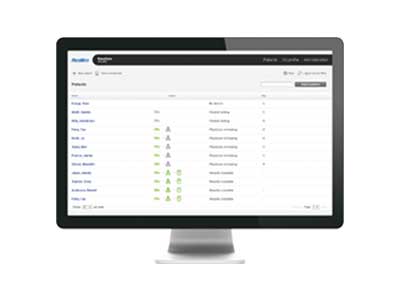
Apneas and hypopneas were defined using the following criteria: Apneas were identified if there was a ≥ 90% reduction in airflow for at least 10 s, and hypopneas were identified if there was a ≥ 30% reduction in airflow for at least 10 s associated with either an oxyhemoglobin desaturation of ≥ 3% (American Academy of Sleep Medicine definition) or ≥ 4% (Medicare definition). Oxyhemoglobin desaturations of at least 3% were marked separately on the oxygen saturation channel, and an oxygen desaturation index (ODI) of ≥ 3% and ≥ 4% was calculated as the number of oxygen desaturation events per hour of recording time. A.) board certified in sleep medicine who was blinded to the results of the automated scoring.

Each sleep recording from both devices was also manually scored and reviewed by a physician (R. For both devices, the overnight sleep recordings were subjected to automated scoring without expert review, and at least 4 h of interpretable recording time were required for inclusion in the study. Signals recorded included nasal pressure through a nasal cannula attached to a pressure transducer, oronasal thermistor, pulse oximetry for oxyhemoglobin saturation, respiratory effort through piezoelectric belts, and body position. The second sample had home sleep testing using the Embletta device. Pulse oximetry was used to assess oxyhemoglobin saturation, and respiratory effort was measured with a pneumatic sensor attached to an effort belt. Nasal airflow was recorded with a nasal cannula connected to a pressure transducer.

The first sample underwent home sleep testing with the ApneaLink Plus device.
Resmed apnealink plus software download manual#
The objective of the current study was to assess the level of agreement in OSA severity between automated scoring without expert review and manual scoring using two distinct type 3 devices for the diagnosis of OSA. Specifically, it remains to be determined whether the severity of OSA as determined by automated scoring will be sufficiently different from manual scoring and expert review, thus justifying the need for such expertise.

Resmed apnealink plus software download portable#
In contrast, the clinical guidelines on the use of unattended portable monitors for the diagnosis of OSA recommend that “evaluation of portable monitoring data must include review of the raw data by a board certified sleep specialist or an individual who fulfills the eligibility criteria for the sleep medicine certification examination.” 8 Although the recommended guidelines are reasonable and appropriate, limited evidence supports or refutes the value of manual scoring of home sleep recordings and subsequent expert review by a sleep specialist. In 2008, the Centers for Medicare & Medicaid Services approved the widespread use of home sleep testing, stating that a home “sleep test must have been previously ordered by the beneficiary’s treating physician.” 7 However, supervision by a sleep physician in the ordering or interpretation of acquired data was not specified. Correspondingly for the health-care provider, automated scoring algorithms embedded within the software accompanying the device have allowed for expeditious diagnosis of OSA by practitioners not necessarily trained in sleep medicine. Equipment that is simple to apply and less cumbersome to use has made home testing more comfortable for the patient. Portable monitoring devices have become easier and more convenient to use for both patients and health-care providers. Tremendous advancements have been made in home sleep testing over the past several years.

6 Accordingly, the impetus for health-care delivery systems and payers to create cost-effective and convenient ambulatory models of OSA diagnosis and treatment has led to the development of home sleep testing. OSA is associated with a multitude of adverse health outcomes, including incident hypertension, abnormalities in glucose metabolism, cardiovascular disease, and stroke. The public health consequences of underdiagnosed OSA are significant, particularly if the condition is left untreated. 4, 5 The low level of case identification is partly due to the patient inconvenience, costs, and inaccessibility often associated with in-laboratory testing. 1‐ 3 Despite the increasing awareness of OSA and the subsequent proliferation of clinical sleep laboratories, OSA remains significantly underdiagnosed. OSA is a common sleep disorder that affects 5% to 15% of the general population.


 0 kommentar(er)
0 kommentar(er)
